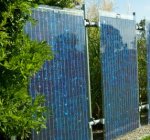Researchers from the University of California (UCLA) say that by incorporating gold nanoparticles into the structure of organic solar cells they can capture more light from the solar spectrum, maximising power conversion by up to 20 percent.
The team from UCLA’s Henry Samueli School of Engineering and Applied Science found they could utilise gold’s enhanced “plasmonic effect” – the ability of metal to absorb sunlight – by sandwiching a layer of gold nanoparticles between two light-absorbing subcells within the organic solar cell.
This plasmonic effect creates a strong electromagnetic current which is then concentrated and captured by the organic photovoltaic layers within the solar cell.
Team leader Professor Yang Yang, says the result is a highly efficient organic solar cell using a relatively simple idea.
“The plasmonic effect happening in the middle of the interconnecting layer can enhance both the top and bottom subcells simultaneously – a “sweet spot” – leading to an improvement in the power conversion efficiency of the tandem solar cell from 5.22 percent to 6.24 percent. The enhancement ratio is as high as 20 percent.”
According to a release from the University, the UCLA team is the first to report a plasmonic-enhanced organic solar cell, and it is also the first time metal nanostructures have been successfully incorporated into an organic photovoltaic device.
Compared to conventional silicon-based solar panels and thin-film solar cells, which dwarf the current efficiency rate of organic photovoltaics, the field is still in its infancy. Organic polymers are cheaper to produce on a large scale, however, and the UCLA team plan to apply their plasmonic technique to a variety of other polymer materials, which they say could provide opportunities for more highly-efficient, multi-stacked tandem solar cells.












































